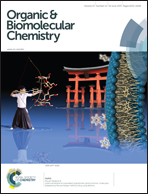Hydroxyethylene isosteres introduced in type II collagen fragments substantially alter the structure and dynamics of class II MHC Aq/glycopeptide complexes†
Abstract
Class II major histocompatibility complex (MHC) proteins are involved in initiation of immune responses to foreign antigens via presentation of peptides to receptors of CD4+ T-cells. An analogous presentation of self-peptides may lead to autoimmune diseases, such as rheumatoid arthritis (RA). The glycopeptide fragment CII259–273, derived from type II collagen, is presented by Aq MHCII molecules in the mouse and has a key role in development of collagen induced arthritis (CIA), a validated model for RA. We have introduced hydroxyethylene amide bond isosteres at the Ala261–Gly262 position of CII259–273. Biological evaluation showed that Aq binding and T cell recognition were dramatically reduced for the modified glycopeptides, although static models predicted similar binding modes as the native type II collagen fragment. Molecular dynamics (MD) simulations demonstrated that introduction of the hydroxyethylene isosteres disturbed the entire hydrogen bond network between the glycopeptides and Aq. As a consequence the hydroxyethylene isosteric glycopeptides were prone to dissociation from Aq and unfolding of the β1-helix. Thus, the isostere induced adjustment of the hydrogen bond network altered the structure and dynamics of Aq/glycopeptide complexes leading to the loss of Aq affinity and subsequent T cell response.


 Please wait while we load your content...
Please wait while we load your content...